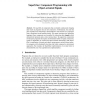Free Online Productivity Tools
i2Speak
i2Symbol
i2OCR
iTex2Img
iWeb2Print
iWeb2Shot
i2Type
iPdf2Split
iPdf2Merge
i2Bopomofo
i2Arabic
i2Style
i2Image
i2PDF
iLatex2Rtf
Sci2ools
ECOOP
2006
Springer
2006
Springer
SuperGlue: Component Programming with Object-Oriented Signals
The assembly of components that can handle continuously changing data results in programs that are more interactive. Unfortunately, the code that glues together such components is often difficult to write because it is exposed to many complicated event-handling details. This paper introduces the SuperGlue language where components are assembled by connecting their signals, which declaratively represent state as time-varying values. To support the construction of interactive programs that require an unbounded number of signal connections, signals in SuperGlue are scaled with object-oriented abstractions. With SuperGlue's combination of signals and objects, programmers can build large interactive programs with substantially less glue code when compared to conventional approaches. For example, the SuperGlue implementation of an email client is around half the size of an equivalent Java implementation.
ECOOP 2006 | Equivalent Java Implementation | Interactive Programs | Large Interactive Programs | Programming Languages |
| Added | 22 Aug 2010 |
| Updated | 22 Aug 2010 |
| Type | Conference |
| Year | 2006 |
| Where | ECOOP |
| Authors | Sean McDirmid, Wilson C. Hsieh |
Comments (0)

